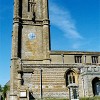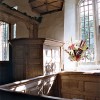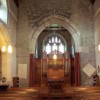In 2003 the West Dorset town of Bridport celebrated the 750th anniversary of the granting of its first charter. This account is a short history of the major developments in the town up to that time and thereafter.
Little is known of the settlement of the area where Bridport grew up, prior to the 9th century. The nearest Iron Age fort is Old Warren at Little Bredy. The name also appeared in a document when land at Little Bredy was granted to Cerne Abbey in 987, but few artefacts of the period from about 4000 BC to 43 AD have been found. The Romans appear to have introduced the tradition of cultivating hemp and flax in the rich alluvial soils of the Brit and Asker River valleys, but did not establish any camp or town on the gentle intervening spur between the valleys.
With the incoming Saxon settlers however, the town’s history can be said to begin. Bridport began as an artificial creation in 878 AD first known as Brydian, just one link in a system of fortified burhs built by King Alfred as a defence against the Danes. The land chosen was part of the royal manor of Bradpole, and therefore a crown possession from the start. Brydian was allotted 760 hides of land, and became a centre of local administration and commerce. The burh was surrounded by a rampart of earth, turf and timber, and was probably surmounted by a timber palisade. Within this enclosure the settlement was laid out on a gridiron pattern with a wide main street. This survives in the present town as the southern end of South Street. Within the burh there would have been ample accommodation for tradesmen, and there would have been several churches.
During the reign of King Athelstan (925 to 939 AD) a mint was established in the burh, though the Brydian mint was relatively unimportant. Coin-production here continued until after the Norman Conquest, though this appears to have ceased soon after. As the town was crown property, it is likely that William I ordered the building of a castle at Bridport, and it has been suggested that a slight elevation in the ground to the east of South Street is probably the denuded remnant of the castle motte.
During the Norman period land in the Bridport area not owned by the Crown was mainly vested in the Church in the form of abbeys. A Church belonging to St.Wandrille’s Abbey existed in Bridport in 1086, and is believed to have been the antecedent of the present St.Mary’s. Many other religious houses were already in existence by the mid 13th century.
The main period of urban development appears to have occurred in the early 13th century. The influx of population from the rural manors into the town necessitated an extension of the town boundaries by 1250. By this time a new town had been laid out to the north of the earlier Saxon burh, with two main streets meeting at a T-junction. These streets replaced South Street as the main streets of the town. Trade was then drawn away from the Saxon settlement and towards the new market area with its wide streets and regular burgages. It was the growth in the town’s economy and status, due largely to the stimulation of industry to meet the demand for rope to supply King John’s military ventures, that led to Bridport qualifying for the receipt of its first Royal Charter from Henry III on June 22nd 1253.
This Charter, which had been obtained principally by the Dean of Wells, Giles de Bridport, effectively founded the borough. In the Town Hall can be seen a roll of the Bailiffs from 1290 together with the original precept from the Sheriff of Dorset to the Bailiff calling for the election of two MP’s. Edward I granted the right to return two members, and twelve burgesses were empowered, from which two Bailiff members were elected. It is recorded that Thomas Newburgh and Robert Hill were the first members representing Bridport at Westminster. From early on, a proportion of Bridport’s population comprised immigrants from Normandy.
St. Andrews was the church of the planned town to the north of, but continuous with the Saxon burh and it is noted that this church was in use as a priory by Carmelite friars around 1265. It formerly stood on the site of the present Market House-cum-Town Hall. Buildings originally occupied the space behind the Town Hall, but these were later demolished. St.Mary’s Church in South Street however is almost certainly older than St.Andrews, though much of the present building dates from the 13th century.
However, early in the 14th century there is evidence of an economic downturn, largely attributed to the wet summers of 1315 and 1316 which severely affected crops and food. Bridport was one of the first coastal towns to suffer the effect of the bubonic plague epidemic, during which peasant and labourer mortality was very high. Despite difficulties, Bridport by the end of the 14th century was the fourth largest borough in Dorset.
It is informative to see how the wills of the victims give an insight into the lives of the town’s citizens at the time. Buildings were in multiple occupation and use. Some of the wills mention land suitable for growing hemp. Land seems to have been in small parcels of 1 rood (about 9.75 acres,) and usually left to surviving family members. The forerunner of the Greyhound Hotel, formerly a tavern, came into the possession of the town authorities by means of a reversion included on a will of 1386.
The market function of the town was originally catered for by The Shambles or Butchers Row, which formerly occupied the road intersection area. Documents record that in 1556 Thomas Balston Bocher was granted two shambles in the market of Bridport for his butchery business. However, the ground floor space of the Town Hall to this day is used as a market. Elizabeth I granted Bridport the right to hold three annual fairs and a Saturday market. The broad span of the main streets today reflects the allocation of space for the market, the fairs, bull baiting, the stocks, pillory and even hangings.
Not least among the trades and industries, which had attracted Bridport’s royal patronage, were the net, rope and sail makers. These industries were fully established by 1250, and were based upon hemp and flax grown locally. The ropewalks needed to bind the rope strands together have left their mark in the long alleyways still to be seen off the main streets. Such was the industry’s importance that in 1322 six Bridport ropers were sent to Newcastle to train workers for the fledgling rope industry there. But by the 15th century rope and sail making were already experiencing the threat of competition from low-cost producers in Genoa, Normandy and elsewhere in England.
At first the workers petitioned Henry VII, warning the King that competition from abroad could devastate the economy of Bridport. When a ropewalk was set up in Burton Bradstock, the ropers of Bridport petitioned Henry VIII to pass in 1530 what might be called “the 5-Mile Act.” This act banned the sale of hemp within 5-mile radius of the town other than at its market and for the maker’s own use. This appears to have worked in the short term, for Bridport was able to maintain its lead.
Although critical to the town’s economy and status, the development of the harbour and port is a matter of considerable ambiguity among historians. The earliest reference to a harbour at Bridport appears in Hundred Rolls of 1280. It is noted that ships were coming up the river as far as the borough by1280, indicating that some quay or harbour must have been in existence from 1256. Then in 1388 Richard II made a grant to Richard Huderesfield for the purpose of re-making the harbour, which by this time had evidently fallen into disrepair. Little had been done, though, towards this end by 1392 when the King issued a second grant, this time to the Bailiff of the Vill of Bridport.
The quay facilities did however receive some help in the 1440’s, when ecclesiastical authorities raised funds for its reconstruction and maintenance. In 1619 James I granted Bridport a Charter “confirming the rights and privileges of the borough” and granted letters to the bailiffs allowing them to raise revenue towards the upkeep of the harbour. Then in 1670 Charles II granted powers to repair the old harbour or construct a new one in return for a levy payable to the exchequer. But the serious effort to build a proper harbour was persistently dogged by silting up of the outlet due to drifting Chesil sand, and would not be realised until the early years of the 18th century, even though sea-borne trade continued throughout this time.
Then in 1588 came the Armada. Two sea battles on the 23rd of July could be heard and seen by the people of Bridport. Bridport men in the Dorset Militia followed the battles eastwards overland until the fight died away in the afternoon. For a time afterwards the town experienced economic difficulties due to the familiar problem of harbour blockage. Also about this time Beaminster and Lyme Regis contributed funds for the building of a market and a school, the latter of which is thought to have stood near the present market house.
Bridport was much involved in the emigration to the New World in the early 17th century, and it has been estimated that about 200 local people sailed to Massachusetts between 1620 and1650. At least some of these would have come from the town or its west Dorset hinterland, including Symondsbury and Askerswell. The town was also assisting the policing of the coast, in operations against pirates operating out of Lulworth Cove and Studland Bay. For example in 1613 the Bailiffs of Bridport paid the princely sum of 11s.3d for expenses incurred in the imprisonment of captive pirates. This fact suggests that some kind of harbour was in operation, despite a reference in Queen Elizabeth’s Charter to a blockage by sea and wind sometime after 1619.
During the Civil War, it appears that Bridport did not suffer the degree of damage or casualty as did Weymouth, Lyme, or Corfe, probably because it was not a defended or walled borough. After the Restoration in 1660 the town’s authorities, woefully short of revenue, resolved that repairs to the Church and the roads would have to come out of parish rates. On the 11th of June 1685, the Duke of Monmouth and his rebel army landed at Lyme and immediately moved to attack the militia at Bridport, though this was based at the east end of the town at the time.
Then, 1721 an act of Parliament legislated for a harbour and piers to be built, these being completed twenty years later. To the west of the harbour a shipyard was established which would be a success from the beginning. It is not known exactly when Nicholas Bools (or Bowles) founded the shipyard, but a 52-ton sloop called ‘North Star’ was, in 1789, the first to leave one of the six slipways at the harbour. Between 1772 and 1879, when the yard closed, altogether 353 timber ships were built and launched, often at the rate of four or five a year for several consecutive years. Many of these vessels were involved in the growing overseas trade, exporting cargoes of rope, sail, nets, butter and cheese, while importing mainly coal timber, hemp and flax.
As in many other English towns there grew up a thriving coterie of clock and watch maker-repairers in Bridport from around 1700. Daniel Freake, John Bishop, J Dashwood, W Brown and Adam Cleak were the craftsmen in the forefront of the local horology business. Cleak, for instance, came from a family of Exeter clockmakers and set up shop in West Street. It is interesting that through his sister’s marriage Adam Cleak had a nephew, John Summerhayes Jr, who emigrated to New York and himself established a clock-making business there in about 1820. It should therefore be pointed out that anyone with this or a similar name living in New York State today may be able to claim Dorset ancestry through this single migrant to the New World.
In 1906, discussions on the planning for secondary schools in Bridport took place. The town experienced a drought from July to October in 1911, during which time a Regatta was held at West Bay. Then in the spring of 1913 a Town Council proposition to provide a Municipal Market for livestock caused much opposition. Bridport had at this time about eleven hundred burgesses, who were to be replaced by the Representation of the People Act of 1918.
In its own way Bridport, like every town and village in the land, had to endure the devastating years of the two World Wars. The invasion of Belgium in August 1914 led that November to the arrival of about 40 warmly welcomed refugees in Bridport. During this conflict the town’s industry went into hyper-drive to produce huge volumes of supplies. Between the wars however, there were as elsewhere, definite signs of a recession. A report headed ‘Ropes, Nets and Halters’ made it clear that this industry was showing every sign of decline and contraction.
Bridport marked the 700th anniversary of the first charter in 1953. By this time the harbour was declared to be no longer a profitable operation. Until the early ‘60’s the population of the town was in decline in response to economic circumstances. By 1963 it had declined to 6,530. The old custom of beating the boundaries was re-instated in September 1968.



